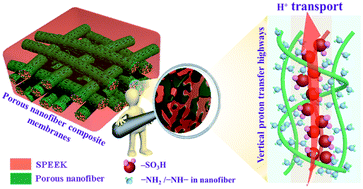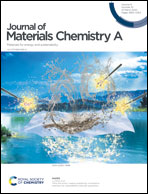Porous nanofiber composite membrane with 3D interpenetrating networks towards ultrafast and isotropic proton conduction†
Abstract
Nanofiber composite membranes (NFCMs) often show fast in-plane ion transport and hold great potential for hydrogen fuel cells if the through-plane conduction can be substantially improved. Herein, we demonstrate a significantly enhanced through-plane proton conduction of NFCM by constructing 3D interpenetrating nanopore networks inside the nanofibers. Hydrophobic ionic liquids are selected as templates, which can form large micelles (15–50 nm) in hydrophilic nanofiber precursor (PVA/PEI) solution. This permits the formation of interconnected, large nanopores inside nanofibers, and then allows the full and uniform entrance of sulfonated poly(ether ether ketone) matrix. The 3D interpenetrating nanopore networks and the enriched acid–base pairs along nanopore walls, serving as proton transfer pathways in the vertical direction, impart porous NFCM (PNFCM) boosted through-plane proton conduction. A remarkable through-plane conductivity of 561 mS cm−1 (80 °C and 100% RH) and a maximum power density of 723 mW cm−2 are readily achieved for PNFCM. Particularly, the anisotropy coefficient significantly decreases to 1.08 from 4.19, ranking as one of the lowest values until now.



 Please wait while we load your content...
Please wait while we load your content...